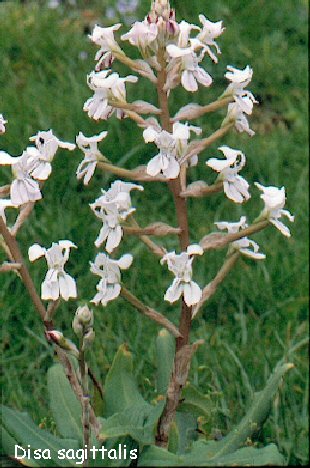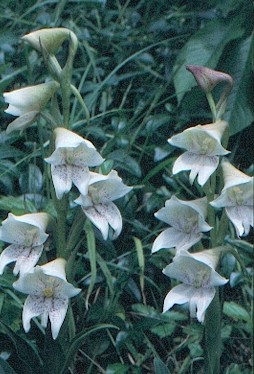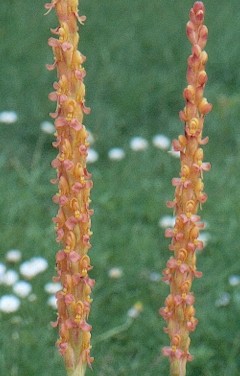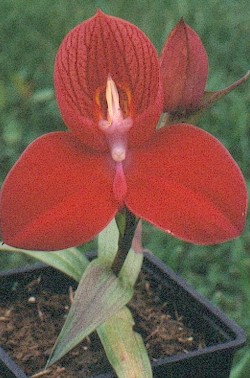| Comments to the offered plants:

Disa sagittalis is easy in culture and pleases every year with very longlasting flowers. Occasionally, the plants increase vegetatively, producing a second daughter tuber. Frost hardy up to -3°C.

Disa crassicornis is a juwel
within terrestrial orchids. Remarkably frost tolerant and suitable
for garden culture. Leaves are frost hardy to -7°C . Protected from strong bare frosts, all plants survived outside, even the last
winters.

Disa chrysostachya. Section Micranthae. Tall , bright orange flower candles. Plants start to grow in early spring and flower in early summer. Fertile and humid soil. Overwinter cool and fairly dry. Easy to culture.

Disa uniflora. Section Disa. Flowers in the northern hemisphere from June to Juli. All year green. New leaves emerge after flowering. Occasional weak feeding during summer. Best a sunny to half shaded place outside in summer, protected from excessive rain. Overwinter cool and not to dry. Frost hardy to minus 3°C.
|
Distribution:
More than 130 species, endemic to Africa. In highland regions
of central- and east-Africa, and also in lower regions of South-Africa.
A few species in Madagascar.
Description:
The various sections of the Disa are very different. Only Disa
unifora and it´s hybrids within the section Disa are fairly distributed
in culture . The flowers of Disa are very characteristic. The
dorsal sepal is prominent and spurred. The lip is small or very
small and is often not protruding from within the flower.
Disa crassicornis:
Section Hircicornes. Robust, up to 60cm tall plants with very
large flowers. The 4 to 5 long basal leaves are slightly to heavily
blotched and resemble Dactylorhiza. The flowers are white to cream
with purple or pink moddling and very pleasently scented. Flowers
are 60mm across and the spur is 90mm long. Flowering months in the
northern hemispere are June and July.
Culture:
Disa crassicornis grows in the Drakensberg escarpment of South-Africa
between 1000 and 2700m. The winters are cold and dry. The summers
are warm and wet. The plants prefer dry conditions during dormancy
(November to March, in the northern hemispere). Leaves overwinter
(if not frozen back) and stay green until the end of summer, altogether
for 15 to 18 months. However, don´t let the soil become completely
dry. New leaves will apear in March/April in the wintergarden. The
flowering stalk develops from the overwintered rosette. In the garden,
the leaves will freeze at temperatures below -7°C and new leaves
will appear not before the end of May. The new rosette develops
from June onwards. Water regular during the growing season. Keep
the soil damp. Potted plants prefer to stay in an under saucer filled
with water. Fetilize monthly with 0,2g/l during the summer months.
Culture sunny during the growing season and shaded during dormancy.
Suitable for garden culture. Survived the last three winters outside,
with a light cover. To stay on the save side, protect the soil from
heavy freezing.
Recommended potting mixes:
100% organic, solely Toresa (impregnated woodfibre). Alternative
50% to 70% fine to medium grade perlite and 50% to 30% organic components.
Favourable are fermented or N-impregnated wood shavings or saw dust.
(Toresa has given very good results). Spagnum moss has given reasonably
good results. Substrates have to be well draining with a pH of 5
to 6.
Disa sagittalis:
Section Coryphaea. Up to 10 leaves forming a rosette. Flower
stalk up to 30cm tall. Up to 30+ flowers. The single bloom is 22mm
high and 25mm wide. Small, dry, sheating, upper leaves. Flowers
white to light mauve with a few darker streaks. Flowering time in
the northern hemisphere is April and May.
Culture:
Disa sagittalis occurs in South-Africa in the summer- as well
as in the winter rainfall region (Karsten Wodrich, Gordon`s Bay,
South-Africa, personal comunication). The offered plants originate
from the winter rainfall region. Dormancy is restricted to the months
June and July/August (northern hemisphere). During this time, the
plants have to be kept completely dry. Leaves appear in August or
September. Regular watering during the growing season is essential.
Culture sunny or slightly shaded. Fertilize monthly with 0.2g/l
until flowering.
Recommended potting mixes:
80% fine to medium grade Perlite (0 to 20 mm). 20% organic
components. Favourable are fermented or N-impregnated wood
shavings or wood fibre. (Toresa has given good results). No
peat. Spagnum moss is suitable. Substrates have to be
well draining with a pH of 5 to 6.
Recommended literatur:
Wild orchids of Southern Africa. J. Stuart, H.P. Linder, E.A.
Schelpe, A.V. Hall, 1982. Macmillan South Africa.(Publishers)(Pty)Ltd.
ISBN 0 86954 070 X.
Growing South African indigenous orchids. Karsten, B. Woodrich,
1997.Balkema ISBN 90 5410 650 6.
Orchids of Kenia. Joyce Stuart, 1996. St Pauls
Bibliographies,Winchester.ISBN 1 873040 28 8.
Orchids of Southern Africa. H.P. Linder and H. Kurzweil,
1999. A.A. Balkema/Rotterdam/Brookfield. ISBN 90 5410 4457.
|



